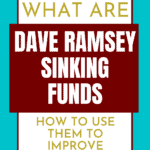THIS POST MAY CONTAIN AFFILIATE LINKS. PLEASE SEE MY DISCLOSURES. FOR MORE INFORMATION.
You might have heard about saving using a sinking fund method but have no idea what it is.
In this post, I will walk you through the idea behind the Dave Ramsey sinking funds strategy, how and why it works, and some of the things to look out for.
In the end, you will be able to set up your budget so that there are no surprise bills and so that you reach your savings goals.
Table of Contents
The Dave Ramsey Sinking Funds Strategy
What Is A Sinking Fund?
The Dave Ramsey sinking fund method is designed to help people reach their financial goals over time by setting aside a certain amount of money per month.
The reason they are called sinking funds is because these major purchases or expenses can ‘sink’ your finances if you don’t plan for them.
Whereas many people will have a general emergency savings fund that is designed to offer them extra cushion and financial security should the need arise, this strategy has you set up separate savings accounts for irregular expenses and both short term and long term savings goals.
For example, some of the financial goals that you may have when you apply the Dave Ramsey sinking fund strategy include:
- Creating a fund to pay for Christmas gifts or birthday gifts
- Working towards having enough money to pay for your dream vacation
- Saving for a big expense like a new house or a car
- Paying off vet bills or medical expenses
- Investing in education or buying new equipment for your career
- Annual membership dues like Amazon Prime membership renewal or Costco membership renewal
- Paying insurance premiums, water bills, HOA fees, or other non monthly expenses
Because a monthly budget typically includes a general savings category or emergency fund savings, having these additional saving goals will give you the peace of mind knowing that you’re actively saving for the things that you really want or need money for.
What Are The Benefits Of Using The Dave Ramsey Sinking Funds Strategy?
We’re all taught the importance of saving.
But when all of our savings are grouped together in one account, it makes it extremely easy to lose track of how much we have saved for specific purposes.
This puts you at risk of taking out too much from your savings account to spend on something you’ve been saving up for, only to discover that you don’t have nearly enough left for another purpose.
- Read now: Learn 28 dumb ways you waste money
To better illustrate this, let’s imagine that you’re saving up to buy yourself a new television.
You’ve been actively setting aside some of your paycheck each month and you decide that it’s finally time to get the TV since it’s on sale.
After a little while, something happens to your car and you need to dip into your emergency fund in order to afford the repairs.
Unfortunately, you weren’t keeping track of how much you were saving, and the money that you used to buy the TV took significantly from your original emergency fund, leaving you with close to nothing left.
This type of problem can happen frequently when savings accounts are mixed together and there’s no way to determine exactly how much of the account should be used for certain purposes once those funds are withdrawn.
Besides having more awareness of what your funds are being saved for, some of the other benefits of using the this strategy include:
Ability To Save For Things You Want Or Need Without Feeling Guilty
Once you’ve established a saving goal, you already have a deadline that you want to meet and a dedicated amount of your paycheck for an automatic transfer each month.
This prevents big splurges that can make some people feel bad about spending a ton of money in one month.
Having Money For Repairs When It Breaks Down
Although we don’t like to think about certain investments getting damaged or losing their effectiveness over time, it’s something that we will have to deal with in the future.
Setting savings goals for car repairs or other repairs or replacements for older appliances and similar unexpected expenses makes it so that we have the money we need to get the job done without dipping into our checking account or other parts of our savings.
Feeling Excitement About The Future
As the old adage goes, “all work and no play makes Jack a dull boy”.
Working constantly and not spending any of the hard-earned money you’ve made on yourself is not the way to go.
No matter how impossible the savings goal may seem, saving a little bit each month can go a long way in helping you afford the stuff that you want.
Saving More Effectively Towards Multiple Goals
Unlike other savings strategies, the Dave Ramsey sinking funds framework can help you save for a wide variety of things that you want.
Just make sure to know where this money is coming from and how it will impact other parts of your budget.
It’s always best to save extra money first for essential expenses and other savings goals and then save for other goals after you paid all of your monthly expenses.
If you find that your current savings strategy isn’t as effective as you need it to be, this strategy may be the better option to go with.
If you are following Dave Ramsey’s Baby Steps, you would incorporate the sinking fund methodology into baby step #4.
How To Take Advantage Of Dave Ramsey Sinking Funds Method
The sinking funds strategy is extremely easy to implement in any monthly budget.
Here are the simple steps to follow.
#1. Create The Sinking Fund Categories You Want
For example, if you want to make sure that you have plenty set aside for Christmas presents, you can create a category dedicated to Christmas spending.
Make sure you take some time to try to cover all your savings goals and annual expenses.
It might help to look back at your previous years credit card statements and bank statements to help you remember some expenses you might be forgetting about.
#2. Decide Where To Save For Each Fund
In some cases, you may decide to set up an additional savings account with your bank.
Today however, you can take advantage of apps that allow you to save towards certain goals without having to have multiple accounts at different banks.
I’m old school in the sense I like having multiple savings accounts.
And most banks allow you to have more than one savings account.
- Read now: Find the best savings account for you
Whatever is most effective for you, use that strategy to store your money away.
#3. Organize And Prioritize Your Sinking Funds
Order your accounts from most important to least important.
At the top of your list should be non-monthly expenses, like HOA fees and insurance premiums since you will need to pay these bills no matter what.
From there, you want to make your emergency fund a priority until you get a year’s worth of expenses in it.
- Read now: Click here to learn how to fund an emergency fund fast
- Read now: Here are the best bank account nicknames to organize your finances
After that, you can organize the remaining goals in order of importance.
If you really want to take your dream vacation, then make that next on the list.
Otherwise, it goes further down.
#4. Figure Out How Much To Save In Each Category
Remember that the amount and the deadline will have to match up when you start planning.
For annual expenses, take the full amount and divide by 12.
This is how much money you need to save each month to pay this bill.
If you have a vacation goal of $10,000 and only 3 months to save, it’s highly unlikely that you’re going to be able to reach that goal.
You will need to make adjustments.
Knowing how to do this is the next step.
#5. Adjust Your Budget
The best way to get ahead financially is to pay yourself first.
- Read now: Learn the simplest way to become rich
So take your most important savings goals you created and move them to the top of your budget in terms of priorities.
Then list out all your expenses.
In this section is where you will put your sinking funds for non-monthly expenses.
After you put down all your expenses, you can list out your remaining savings goals.
Now run through the numbers and see if your budget works.
Most likely it won’t and you need to adjust.
Play with the numbers in your savings goals to get your budget to work.
You can also reduce some spending amounts too if you want.
For many people, you will find that you need to either change the deadline of your savings a goal or need to save a lower amount overall.
With all of this in place, you’re ready to take advantage of the Dave Ramsey sinking funds strategy!
Final Thoughts
At the end of the day, using the Dave Ramsey sinking funds strategy to pay for non-monthly expenses and save for your goals is a smart move.
Not only does it help you improve your financial situation and reach your goals and limit surprise expenses from ruining your budget, but having separate accounts motivates you more than having one single account.
I highly encourage you to start using this method in your budget so you too can experience the many benefits it has to offer.
- Read now: Find out the 17 best personal budget methods to try
- Read now: Discover 41 great money saving challenges
- Read now: Learn why you should avoid Dave Ramsey investing advice
I have over 15 years experience in the financial services industry and 20 years investing in the stock market. I have both my undergrad and graduate degrees in Finance, and am FINRA Series 65 licensed and have a Certificate in Financial Planning.
Visit my About Me page to learn more about me and why I am your trusted personal finance expert.



